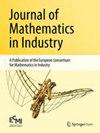Mechanical assessment of defects in welded joints: morphological classification and data augmentation
IF 1.7
Q3 MATHEMATICS, INTERDISCIPLINARY APPLICATIONS
引用次数: 2
Abstract
We develop a methodology for classifying defects based on their morphology and induced mechanical response. The proposed approach is fairly general and relies on morphological operators (Angulo and Meyer in 9th international symposium on mathematical morphology and its applications to signal and image processing, pp. 226-237, 2009) and spherical harmonic decomposition as a way to characterize the geometry of the pores, and on the Grassman distance evaluated on FFT-based computations (Willot in C. R., Méc. 343(3):232–245, 2015), for the predicted elastic response. We implement and detail our approach on a set of trapped gas pores observed in X-ray tomography of welded joints, that significantly alter the mechanical reliability of these materials (Lacourt et al. in Int. J. Numer. Methods Eng. 121(11):2581–2599, 2020). The space of morphological and mechanical responses is first partitioned into clusters using the “k-medoids” criterion and associated distance functions. Second, we use multiple-layer perceptron neural networks to associate a defect and corresponding morphological representation to its mechanical response. It is found that the method provides accurate mechanical predictions if the training data contains a sufficient number of defects representing each mechanical class. To do so, we supplement the original set of defects by data augmentation techniques. Artificially-generated pore shapes are obtained using the spherical harmonic decomposition and a singular value decomposition performed on the pores signed distance transform. We discuss possible applications of the present method, and how medoids and their associated mechanical response may be used to provide a natural basis for reduced-order models and hyper-reduction techniques, in which the mechanical effects of defects and structures are decorrelated (Ryckelynck et al. in C. R., Méc. 348(10–11):911–935, 2020).焊接接头缺陷的力学评定:形态分类和数据增强
我们开发了一种基于其形态和诱导机械响应的缺陷分类方法。所提出的方法是相当通用的,依赖于形态学算子(Angulo和Meyer在第9届国际数学形态学及其在信号和图像处理中的应用研讨会上,pp. 226-237, 2009)和球面谐波分解作为表征孔隙几何形状的方法,以及基于fft计算评估的Grassman距离(Willot in C. R., msamac .)。(3):232 - 245,2015),用于预测弹性响应。我们在焊接接头的x射线断层扫描中观察到一组被困的气孔,并对其进行了实施和详细说明,这些气孔显著改变了这些材料的机械可靠性(Lacourt et al. in Int)。j .号码。方法工程学报,121(11):2581-2599,2020)。首先利用“k-介质”准则和相关的距离函数将形态和力学响应空间划分为簇。其次,我们使用多层感知器神经网络将缺陷和相应的形态表征与其机械响应联系起来。如果训练数据包含足够数量的代表每个机械类的缺陷,则该方法可以提供准确的机械预测。为此,我们通过数据增强技术来补充原始的缺陷集。对孔隙符号距离变换进行球谐分解和奇异值分解,得到人工生成的孔隙形状。我们讨论了本方法的可能应用,以及如何使用介质及其相关的机械响应来为降阶模型和超约化技术提供自然基础,其中缺陷和结构的机械效应是去相关的(Ryckelynck et al. in C. R., m。348(年级):911 - 935,2020)。
本文章由计算机程序翻译,如有差异,请以英文原文为准。
求助全文
约1分钟内获得全文
求助全文
来源期刊

Journal of Mathematics in Industry
MATHEMATICS, INTERDISCIPLINARY APPLICATIONS-
CiteScore
5.00
自引率
0.00%
发文量
12
审稿时长
13 weeks
 求助内容:
求助内容: 应助结果提醒方式:
应助结果提醒方式:


